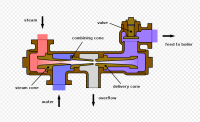








An injector is a type of pump. There are two varieties of injector, non-lifting and lifting.
Early History
The injector was invented by a Frenchman, Henri Giffard in 1858 and patented in the United Kingdom by Messrs Sharp Stewart & Co. of Glasgow. Motive force is provided at the inlet by a suitable high-pressure fluid.
An empirical application of the principle was in widespread use on steam locomotives before its formal development as the injector, in the form of the arrangement of the blastpipe and chimney in the locomotive smokebox. The sketch on the right shows a cross section through a smokebox, rotated 90 degrees; it can be seen that the same components are present, albeit differently named, as in the generic diagram of an injector at the top of the article. Exhaust steam from the cylinders is directed through a nozzle on the end of the blastpipe, to create a negative pressure inside the smokebox and entrain the flue gases from the boiler which are then ejected via the chimney. The effect is to increase the draught on the fire to a degree proportional to the rate of steam consumption, so that as more steam is used, more heat is generated from the fire and steam production is also increased. The effect was first noted by Richard Trevithick and subsequently developed empirically by the early locomotive engineers; Stephenson's Rocket made use of it, and this constitutes much of the reason for its notably improved performance in comparison with contemporary machines.